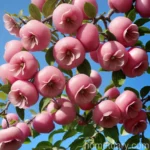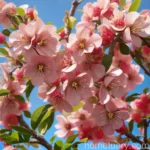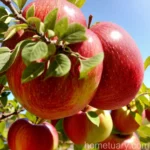Flowering Crabapple (Malus x moerlandsii ‘Profusion’)
Introduction to Flowering Crabapple
Flowering crabapples are a stunning addition to any landscape, offering beautiful blooms in the spring, colorful foliage in the fall, and decorative fruit that persists into the winter months. Among the numerous cultivars available, the Malus x moerlandsii ‘Profusion’ stands out for its exceptional ornamental features and adaptability.
In this comprehensive guide, we will delve into the diverse aspects of growing and caring for the flowering crabapple, with a specific focus on the Malus x moerlandsii ‘Profusion’ variety. From cultural requirements and propagation techniques to pest and disease management, this article aims to equip you with the knowledge and insights needed to cultivate thriving and visually captivating flowering crabapple trees.
Flowering Crabapple (Malus x moerlandsii ‘Profusion’) Overview
Flowering Crabapple Characteristics
The Maluis x moerlandsii ‘Profusion’ is a deciduous tree known for its stunning display of pinkish-red flowers in the spring, deep purple leaves that transition to bronze in the fall, and small, persistent red fruit. This cultivar typically reaches a height of 15-20 feet and boasts a spreading canopy, making it an excellent choice for providing shade and ornamental value in gardens and landscapes.
Beautiful Features of Malus x moerlandsii ‘Profusion’
- Flowers: The ‘Profusion’ crabapple variety is admired for its abundant, rosy-pink blossoms that cover the tree in spring, adding a burst of color to the surroundings.
- Foliage: Its deep purple leaves create a striking contrast against the pink blooms. During autumn, the foliage develops a bronze hue, enhancing the visual appeal of the tree.
- Fruit: The tree bears small, glossy red fruit that persist into the winter, providing visual interest and serving as a valuable food source for wildlife.
Profusion Crabapple Cultivar Details
- Scientific Name: Malus x moerlandsii ‘Profusion’
- Family: Rosaceae
- Common Name: Flowering Crabapple
- Type: Deciduous Tree
- Mature Height: 15-20 feet
- Mature Width: 15-20 feet
- Growth Rate: Moderate
The ‘Profusion’ crabapple variety exemplifies the harmonious blend of ornamental beauty and ecological significance, making it a favored choice among gardeners and landscapers.
Best Practices for Growing Flowering Crabapples
Culture
Water
While established flowering crabapples are generally tolerant of dry conditions, adequate water is crucial during periods of drought and in the first few years after planting. A consistent watering schedule, especially during the growing season and in hot climates, promotes healthier foliage, blooming, and fruit production.
Sunlight
Flowering crabapples thrive in full sun, receiving at least 6-8 hours of direct sunlight daily. This exposure fosters robust growth, abundant blossoms, and vibrant foliage, ensuring the tree’s overall vigor and ornamental appeal.
Fertilizer
Fertilizing flowering crabapples can enhance their growth and blooming capacity. A balanced, slow-release fertilizer applied in early spring supports robust foliage development and promotes a profusion of flowers. It is essential to follow the manufacturer’s instructions when applying fertilizers to prevent over-fertilization, which can lead to excessive vegetative growth at the expense of flowering.
Soil
Well-drained, slightly acidic soils are ideal for growing flowering crabapples. Prior to planting, it is advisable to amend the soil with organic matter to improve its structure and fertility. Regular soil testing can help monitor the pH and nutrient levels, allowing for targeted amendments to maintain optimal growing conditions.
Pruning
Pruning is crucial for shaping the tree, removing dead or diseased branches, and promoting airflow and light penetration within the canopy. It is advisable to prune flowering crabapples during the dormant season to minimize stress and encourage vigorous regrowth. Proper pruning practices contribute to the tree’s overall health, aesthetics, and blooming performance.
Propagation of Malus x moerlandsii ‘Profusion’
Propagation Methods
Flowering crabapples can be propagated through various methods, including:
- Seed Propagation: Harvesting and germinating seeds from the fruit
- Cutting Propagation: Using stem cuttings to propagate genetically identical clones
- Grafting: Joining a scion from the desired cultivar onto a compatible rootstock
Each propagation method has its own set of requirements and considerations, and success rates may vary. For home gardeners and enthusiasts, cutting propagation and grafting are commonly employed due to their efficacy in preserving the desirable traits of the ‘Profusion’ cultivar.
Successful Propagation Tips
- Select healthy, disease-free plant material for propagation
- Provide optimal environmental conditions, such as consistent moisture and humidity, to support root and shoot development
- Employ sterile tools and equipment to minimize the risk of contamination and infection
- Monitor the propagation process closely, adjusting cultural practices as needed to maximize success rates
Flowering Crabapple (Malus x moerlandsii ‘Profusion’) Care
Container Popularity
The Malus x moerlandsii ‘Profusion’ variety is well-suited for container cultivation, making it an excellent choice for urban gardens, patios, and small spaces. When grown in containers, the tree’s ornamental features can be showcased in a confined area, adding a touch of natural beauty and elegance to any setting.
Container Common Diseases
While container cultivation offers numerous advantages, flowering crabapples may still be susceptible to certain diseases when grown in pots or containers:
- Root Rot: Excessive moisture and poor drainage can lead to root rot, causing stunted growth, yellowing foliage, and wilting.
- Powdery Mildew: High humidity and inadequate air circulation in container environments can promote powdery mildew, manifesting as white, powdery patches on leaves and shoots.
To minimize the risk of container-specific diseases, it is essential to maintain proper watering practices, provide adequate drainage, and ensure sufficient airflow around the tree.
Common Pests
When cultivated in containers, flowering crabapples may encounter pests such as aphids, scale insects, and spider mites, which can negatively impact the tree’s health and aesthetics. Regular monitoring and proactive pest management are essential for preserving the tree’s vitality and ornamental value.
Malus x moerlandsii ‘Profusion’ and its Popular Uses
Landscaping Beauty
The Malus x moerlandsii ‘Profusion’ is widely utilized in landscape design to enhance the visual appeal of gardens, parks, and public spaces. Its striking floral display, colorful foliage, and persistent fruit make it an invaluable addition to diverse landscaping scenarios, ranging from formal settings to naturalistic plantings.
Enhancing Your Landscape with Flowering Crabapple Trees
- Integrate flowering crabapples into mixed borders to introduce seasonal interest and diversity
- Utilize the trees as focal points, accentuating their captivating blooms and foliage
- Incorporate them into urban landscapes to introduce greenery, biodiversity, and aesthetic charm
The versatility and year-round ornamental value of the ‘Profusion’ crabapple make it a sought-after choice for creating visually dynamic landscapes that evolve throughout the seasons.
Ecological Significance
Apart from their aesthetic appeal, flowering crabapples play a crucial ecological role by providing food and habitat for various wildlife species. The nectar and pollen-rich flowers attract pollinators such as bees and butterflies, contributing to the ecological balance and biodiversity within their habitat.
The Significance of Pollination for Flowering Crabapple Trees
- Bees, including honeybees and native solitary bees, are the primary pollinators of crabapple flowers
- Pollination leads to the formation of fruit, which serves as a vital food source for birds and small mammals during the winter months
- Flowering crabapples contribute to the overall health and resilience of local ecosystems through their interactions with pollinators and wildlife
By acknowledging the ecological significance of flowering crabapples, gardeners and horticulturists can foster a deeper appreciation for these trees and their role in supporting biodiversity.
Disease Diagnosis and Pest Management
Disease Diagnosis
Powdery Mildew (Podosphaera leucotricha)
Symptoms:
- White, powdery spots on leaves, shoots, and flower buds
- Distorted or stunted growth in severe cases
- Premature leaf drop
Management:
- Prune and dispose of infected plant material
- Apply fungicidal sprays as preventive or curative measures
- Improve air circulation and reduce humidity to discourage disease development
Apple Scab (Venturia inaequalis)
Symptoms:
- Olive-green to black lesions on leaves and fruit
- Defoliation and reduced fruit quality
- Favorable in wet, humid conditions
Management:
- Remove and destroy fallen leaves and fruit to reduce overwintering sources of the pathogen
- Apply fungicidal sprays preventatively, especially during wet periods
- Choose resistant cultivars to minimize the risk of infection
Pest Management
Aphids
Aphid Identification:
- Small, soft-bodied insects found on new growth and undersides of leaves
- May be green, black, or brown, depending on the species
- Feeding can lead to distorted growth and sticky honeydew residue
Aphid Control:
- Introduce natural predators such as ladybugs and lacewings
- Use a strong blast of water to dislodge aphids from the foliage
- Apply horticultural oils or insecticidal soaps for severe infestations
Spider Mites
Spider Mite Identification:
- Tiny arachnids that feed on plant sap, causing stippling and webbing
- Commonly found in hot, dry conditions
- Infestations may lead to leaf discoloration and reduced vigor
Spider Mite Control:
- Increase humidity to discourage mite activity
- Utilize predatory mites or beneficial insects for biological control
- Apply miticides if necessary, targeting the undersides of leaves where mites congregate
Proactive monitoring, prompt identification, and targeted management strategies are vital for mitigating the impact of diseases and pests on flowering crabapples, preserving the trees’ health and ornamental value.
Conclusion
The Malus x moerlandsii ‘Profusion’ stands as an exemplar of ornamental charm, ecological significance, and landscape versatility within the realm of flowering crabapples. Its captivating flowers, vibrant foliage, and persistent fruit make it a cherished selection for homeowners, horticulturists, and landscape architects seeking to enrich their outdoor spaces with natural beauty and ecological vitality.
By embracing best practices for growing, caring, and maintaining flowering crabapples, individuals can cultivate thriving and visually enchanting trees that contribute to the aesthetic, ecological, and cultural tapestry of their surroundings. Whether featured as a standalone specimen or integrated into diverse planting schemes, the ‘Profusion’ crabapple variety holds the potential to inspire and enrich the outdoor experience, showcasing the enduring allure of flowering trees in horticultural and environmental contexts.
References
-
“Flowering Crabapples.” The Morton Arboretum, www.mortonarb.org/trees-plants/tree-plant-descriptions/flowering-crabapples.
-
“Planting and Care of Trees.” Arbor Day Foundation, www.arborday.org/trees/planting.
-
“Diseases and Pests of Crabapple.” University of Missouri Extension, www.extension.missouri.edu/p/g6011.
-
Dirr, Michael A. Manual of Woody Landscape Plants: Their Identification, Ornamental Characteristics, Culture, Propagation and Uses. Stipes Publishing L.L.C., 2009.
-
Gilman, Edward F., and Watson, Dennis G. *Malus x moerlandsii: ‘Profusion’ Crabapple.” UF/IFAS Extension, edis.ifas.ufl.edu/fp010.
-
“Powdery Mildew of Trees and Shrubs.” Cornell University, plantclinic.cornell.edu/factsheets/powderymildewtree-and-shrub.pdf.
-
“Apple Scab on Crabapples and Apples.” University of Illinois Extension, ipm.illinois.edu/diseases/series100/rpd106/.
-
“Integrated Pest Management in the Home Landscape.” University of California Statewide Integrated Pest Management Program, www.ipm.ucanr.edu/PMG/PESTNOTES/pn7410.html.















